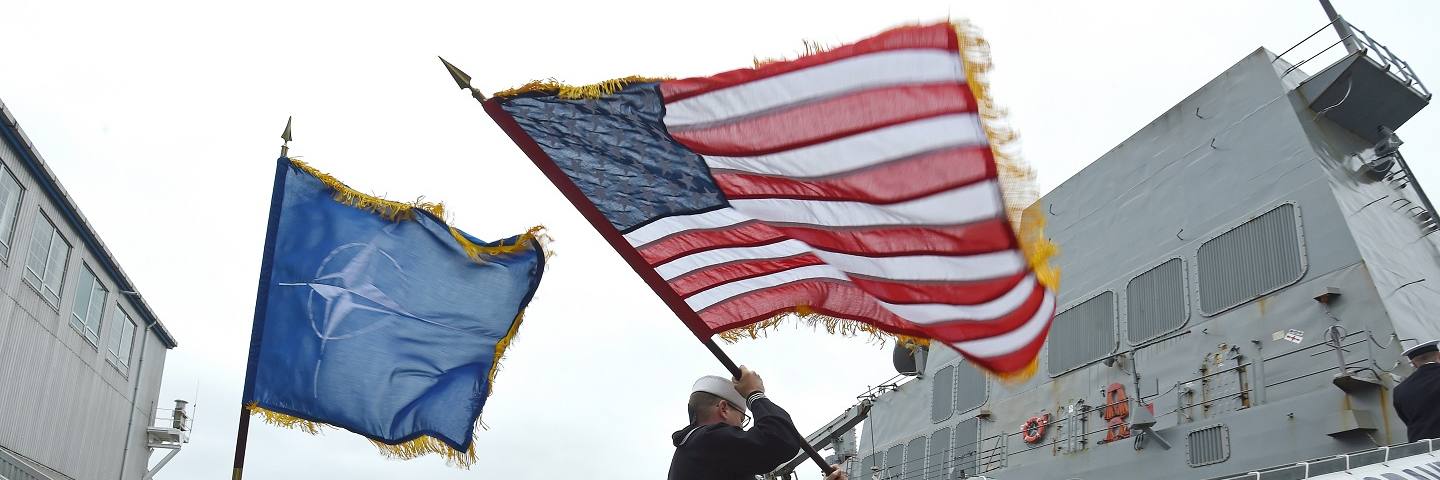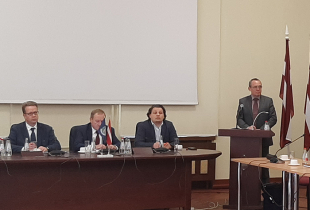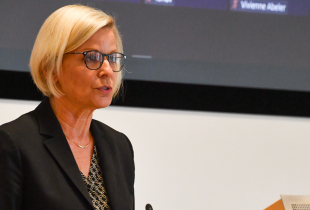
The New Dynamic in the East: Conflicts, Vulnerability, and (Dis)Order
Introduction
Between 11-15 January 2016, the George C. Marshall European Center for Security Studies, a German-American partnership, brought together fifty-eight military and civilian mid- to senior level security policy practitioners and experts from twenty-eight countries in order to collaborate on our first European Security Seminar East (ESS-E). The group’s task was to explore how best to relate to the Russian Federation in the future. Participants were divided into five working groups that addressed: 1) instruments of national power; 2) protracted conflicts; 3) transnational organized crime, political corruption, and undermining political institutions; 4) economic integration and disintegration; and 5) energy security.
The working group sessions were designed to generate three outputs; in particular, we made explicit the assumptions that underpinned strategic choices. First, possible alternative Euro-Atlantic strategic postures towards Russia and shared neighbors were identified and evaluated. Second, we sought to highlight - through discussions with representatives of Russia’s neighbors - the range of strategic thinking (preferences, attitudes, ideas, and expectations) and to explore how to mitigate frictions between states with differing strategic postures and national security priorities. Third, we wished to inform international policies by generating timely and useful strategic analysis. This edition of Security Insights is the result of these deliberations.
Three Strategic Options
How might the Euro-Atlantic security community, which consists of EU and NATO member states, best manage a destabilized and deteriorating relationship with Russia? Discussions within this community have consistently demonstrated that the desired end goal of Western strategy - a return of Russia to the global community as a constructive partner that adheres to established rules and behavior and is a force for stability - is clearly shared by all partners. Yet even though similar goals are shared (security, peace, rule of law, etc.), the Euro-Atlantic security community continuously reflects on the effectiveness of current strategy toward Russia. Working group discussions focused on three strategic options, making explicit their characteristics, organizing rationales, and embedded assumptions.
Option I - Reset 2.0: Proponents of this policy option emphasize the need to double down on the notion that the promotion of economic and market reform encourages political pluralism, which leads to stability, prosperity, and a strong Russia that is integrated into global and regional institutions. This policy has been in place since 1990 and has been consistently adopted by all subsequent U.S. administrations as well as European allies. It first found expression in the “Enlargement and Engagement” strategy of President Clinton in the 1990s, followed by the NATO-Russia Council and EU strategic partnerships of the 2000s, and Reset 1.0 at the start of President Obama’s first administration. Japanese Prime Minister Shinzo Abe’s reconciliatory offer of G7 “constructive engagement” with Russia in January 2016 is in line with this approach.
The underlying rationale is that this option will promote confidence and mutual understanding as to benign intent and in so doing create an environment in which Russia and the West both adapt existing and adopt new policies to reestablish cooperative and mutually beneficial relations. The embedded assumption here is that the breakdown in relations is based on mutual misunderstandings and misperceptions and that once these are clarified, stable cooperative relations can be resumed.
Option II - Containment 2.0: Advocates of containment recommend the adoption of a policy mix of dialogue, defense, and deterrence. Through political engagement with Russia, the door can be kept open for its return to a rules-based regional order. At the same time, through defense, deterrence, and the promotion of resilience and good governance in the shared neighborhood, we can work to prevent malign intent from becoming active subversion. This policy mix was adopted following the annexation of Crimea in March 2014 and is reminiscent of the “peaceful coexistence” deterrence and détente approach of the 1970s, which in turn was the closest approximation to George Kennan’s original prescription (i.e., Containment 1.0).
The underlying rationale is that increasing pressure from both the Russian people and Russian business elites as well as Russia’s obvious economic decline could combine to persuade the Russian leadership that an anti-Western policy leads to Russian weakness. This diminishes Russia’s Great Power status, so policy changes will follow. The embedded assumption here is that Russia is a rational and pragmatic actor that realizes “It’s the economy, stupid!” Russia will seek to reverse the consequences of semi-isolation, which is exacerbating poor domestic policy choices, if only for the sake of regime survival. Self-preservation is the most powerful motivator for behavioral change. Continued dialogue facilitates Russia’s eventual return to and reintegration into the Euro-Atlantic order.
Option III - Confrontation 1.0: This option represents a new approach that suggests even limited and transactional political engagement should be abandoned, leaving Russia fully isolated. This approach has no historical precedent, though its closest antecedents may be the Cold War in its hottest phases, such as the 1948 Berlin Airlift, the 1956 Budapest Uprising, the Cuban Missile Crisis of 1962, the Prague Spring in 1968, and the Polish Crisis in the early 1980s. Russia’s nearest neighbors are to be supported militarily to enhance their right to self-defense.
The underlying rationale is that the Euro-Atlantic security community has an extremely limited ability to change Russian behavior - only the Russian leadership can change their choices and actions. Russia’s leadership currently lacks the will to do this, however, as it not only believes the status quo is already one of confrontation but also that confrontation with the West is in fact a global public good - it sanitizes global order. The embedded assumption is that Russia understands and respects the threat of the use of force above all and that only a steadfast, united, and clear-cut Western response will change Russian behavior.
Finally, rising investment in military modernization has included improved training and equipment for Special Forces, as evidenced by the “polite little green men” in unmarked uniforms deployed inside Ukraine. Cyber attacks, brandishing Russia’s nuclear arsenal, and research into “twenty-first century” biological, ecological, and radiological weapons are further examples of the fruits of these investments. Together these tactics seek to generate sufficient confusion and undermine the will to resist Russian goals. Parallel aims are the division of the West and the discrediting of democracy as decadent, dysfunctional, and destabilizing.
Reality Check: Pulsing the Neighborhood – Sharing Perspectives
The logic, operating principles, and embedded assumptions in each of these strategic options need to be checked against reality. How does Russia understand what each strategic posture represents? How does Russia calculate costs and benefits? Is this in terms of its Great Power status, as a functioning state or resource allocation (and therefore power distribution) within the elites? In reviewing the strategic options, the group was willing to question embedded assumptions. A clear preference emerged in support of Containment 2.0, with agreement as to how this strategy can be further enhanced and strengthened. Each strategic option is addressed in turn below before highlighting areas of consensus within the group with regard to the Euro-Atlantic security community’s strategic approach to Russia.
- Questioning Reset 2.0: The embedded assumption is that the breakdown in relations is based on mutual misunderstandings and perceptions and that once this is clarified, stable and cooperative relations can be resumed. This assumption was challenged on a number of grounds. First, for it to be valid, trust must be present. Trust is the prerequisite for cooperation and engagement as it underpins the principle of diffuse reciprocity; over time, the costs and benefits of a relationship with Russia would even out. After Crimea and sustained anti-Western rhetoric, a trust deficit has only increased. Reset 2.0 would fracture western solidarity and unity. Is the idea of bridge-building effective, considering the fundamentally different interests and values of a liberal West - one that promotes tolerance, respect, open society, and freedoms - and an explicitly anti-liberal, national conservative Russia? There will only be cooperation and integration on Russian terms; is the Euro-Atlantic security community ready to accept these terms? Second, Russia understands integration and engagement not as a positive-sum proposition, but in terms of a zero-sum integration dilemma, thus such a strategy would only further antagonize Russia. Third, Russia has been said to exhibit “anti-fragile” characteristics, that is to say, it thrives in unpredictability, instability, and disorder, but is vulnerable to tranquility. If this is so, such a strategy would destabilize the regime, forcing it to escalation in its external relations to avoid the perils of perfidious peace. If Russia is not anti-fragile, then an escalation of aggression still brings it clear territorial gains, consolidates domestic society, and rewrites the norms that govern the Euro-Atlantic order.
- Questioning Containment 2.0: The embedded assumption here is that Russia, as a rational pragmatic actor with a failing economy, will respond positively to a defense, deterrence, and dialogue policy mix, if only for the sake of regime survival. This assumption was challenged on a number of grounds. First, with regard to deterrence, the classical question remains: “how to deter whom with what?” With regard to dialogue, it is particularly difficult to on the one hand keep a door open to Russia, while on the other to manage a Russian spoiler response. For the Euro-Atlantic security community, the challenge is how to maintain communication but not business as usual. Second, working with Russia only when it is a necessary part of a solution or to manage a priority global issue would mean that NATO and EU member states would need to secure agreement, which could undermine solidarity and unity. While the U.S. can utilize Russia’s need for American validation by offering a seat at the table in return for necessary cooperation, what can Europeans offer in order to secure necessary Russian cooperation? This is certainly a key question for the EU in the context of the strategic review of the EU and of the review of the European Neighborhood Policy. Third, there is a problem of signaling. This policy mix could provide opportunities for Russia to instrumentalize partners and policies. Russia may also understand it as a positive option; domestically, it allows for semi-mobilization and consolidation of Russian society and elites, while in foreign policy terms it represents “Yalta-Potsdam II” as well as a return to spheres of influence and strategic balance, which Russia considers stabilizing.
- Questioning Confrontation 1.0: The embedded assumption is that Russia understands and respects the threat of the use of force above all and that only a steadfast, united, and clear-cut Western response will influence Russian behavior. This assumption was challenged on a number of grounds. First, how can a strategy of confrontation with Russia prevent escalation and direct military conflict, particularly when levels of misunderstandings and misperceptions are even worse than during the Cold War? The risks associated with this strategy are high, particularly given the context of a rapidly declining Russian economy, high popularity ratings for the current president, no viable obvious leadership alternative, and a regime determined to cling to power. The advantages of the (albeit very low) possibility of immediate success must be weighed against Russian fear of being cornered and other hostile reactions. Moreover, the adoption of this strategy also accepts that there is no management of the global strategic agenda and therefore accepts the proposition that we live in a “G-Zero” world. Second, Confrontation 1.0 may further isolate and insulate a Russian population from the external world and allow Russia to adopt a low cost, high gain spoiler strategy based on a new model of subversion. Power is relative. Russia has a higher pain threshold and negative-sum responses appear rational. If Russia cannot strengthen itself and achieve through agreement a sphere of influence, it can still work to weaken the West and create a destabilized buffer zone in the shared neighborhood. Russia has non-traditional IR tools at hand, including networks of intelligence officials, organized crime groups, warlords, oligarchs, and corrupted business elites and institutions; protracted conflicts; energy resources; cyber/information warfare tools; and private armies/militias supported by “little green men,” perhaps not so “polite” the second time around. These foreign policy tools are supported by a viable business model; it would both pay for itself (it could even generate profit for its participants and directing state structures) and so be self-sustaining. It also achieves some levels of deniability and so avoids direct confrontation with the West and builds on current Russian potential. Third, Georgia, Moldova, Ukraine, Belarus, and Azerbaijan would become front line states and a zone of resistance and conflict. Do EU and NATO member states have the strategic patience, persistence, and resolve to maintain unity and solidarity in the face of confrontation? Can the Euro-Atlantic security community develop a new grammar, operating procedures, and doctrines to manage confrontation? Can we manage Russia’s likely asymmetric response, which itself will be more aggressive, violent, unpredictable, and corrosive than ever before?
Toward Smart Containment
The group consensus was that the Euro-Atlantic security community has very little influence over Russia’s behavior and that behavioral change rarely lasts unless it is self-generated. The performance of the Russian economy and how this creates political legitimacy challenges to the Russian elite will drive behavioral and policy changes. Ideally, Russia may seek greater accommodation with the West. A more stable international environment would enable Russia to focus on its turbulent domestic agenda and the need to formulate a more sustainable development model, the lack of which is the real source of insecurity for Russia. In the worst case, Russia may double down, dig in, and tighten the screws further, using autarchy, populism, and perhaps Russian nationalism and increased anti-Westernism to mobilize its population and account for economic collapse. A change in the Russian elite does not necessarily mean a change in the mindset: there is a widespread idea that the next leader will not be as “moderate” as Putin. Putin declares himself to be a nationalist; whoever is more nationalist than Putin will be perceived to be an extremist.
Given the lack of Western influence on Russian behavior, particularly its leadership, the group determined that Containment 2.0 was the most viable strategy to adopt. Smart containment and engagement maintains flexibility and has lower escalation potentials, though it involves a greater need for coherence, commitment, and strategic patience over a longer period. In addition, Containment 2.0 recognizes that threat perceptions of Russia differ across Europe. Some states, especially in Central and Eastern Europe, have historically good ties - as well as significant trade and economic relations today - with the Russian Federation. Containment 2.0 allows the West to balance interests and focus on mitigation measures; while we cannot change Russia, we can make ourselves stronger and more resilient. In addition, whatever strategy the West adopts, the prospects of an internally destabilized Russia increases the dangers of escalation: “when the bread is very scarce, the circuses need to be very interesting.” Containment best manages worst case alternative future scenarios.
In addition to validating a general strategic approach, consensus was achieved around the following general propositions, which, if adopted, would further strengthen and enhance Containment 2.0, making it “smart”:
- Improved situational awareness, including more accurate estimates (intelligence) of Russian capacity and intent, is needed.
- A more coherent communications strategy towards Russia, as well as counter propaganda efforts, should be coordinated and prioritized.
- Sanctions have more of a symbolic value in signaling Western unity than an economic effect on Russia. Such demonstrations of unity and solidarity are important. Sanctions can target “hawks” and reward “doves,” recognizing that power is layered in Russia, so differentiated engagement is possible.
- Dialogue with Russian civil society and independent media are all long term but necessary parts of any strategy toward Russia. It leaves open the door for Russia’s return to the European security order. We need to consolidate Track I/II contact lines with Russia, as well as allies and partners, and broaden the current policy approach to include more carrots alongside the sticks in order to moderate escalatory tendencies.
- Defense and deterrence priorities include extending NATO’s air defense umbrella as well as practical cooperation with non-NATO partners. A common (European) Cyber Defense Policy must also be developed.
- Resilience - in the form of strong institutions, good governance, civil society oversight, and accountable governments - is understood as a necessary end in and of itself as well as a means to reduce opportunities for the Russian Federation to exploit weaknesses and vulnerabilities of EU and NATO member states, friends, and allies in the shared neighborhood.
For Academic Citation
Graeme P. Herd and Ralf Roloff, “The New Dynamic in the East: Conflicts, Vulnerability, and (Dis)Order,” Marshall Center Security Insight, no. 12, January 2016, https://www.marshallcenter.org/en/publications/security-insights/new-dynamic-east-conflicts-vulnerability-and-disorder-0.
About the Authors
Dr. Graeme P. Herd Professor is a Pr ofessor of Transnational Security Studies at the Marshall Center and Deputy Director of the ESS-E.
Professor Dr. Ralf Roloff is the Senior German Professor (since 2003) at the Marshall Center and is the Director of the ESS-E.
The co-authors would like to acknowledge the stimulating insights and observations offered by our ESS-E speakers, participants, working group leaders, the leadership team, and rapporteurs.
The Marshall Center Security Insights
The George C. Marshall European Center for Security Studies in Garmisch-Partenkirchen, Germany, a German-American partnership, is committed to creating and enhancing worldwide networks to address global and regional security challenges. The Marshall Center offers fifteen resident programs designed to promote peaceful, whole of government approaches to address today’s most pressing security challenges. Since its creation in 1992, the Marshall Center’s alumni network has grown to include over 13,715 professionals from 155 countries. More information on the Marshall Center can be found online at www.marshallcenter.org.
The articles in the Security Insights series reflect the views of the authors and are not necessarily the official policy of the United States, Germany, or any other governments.

